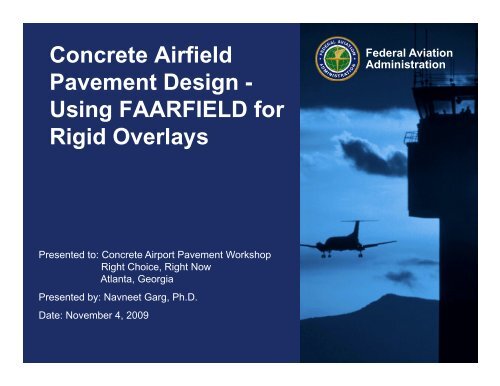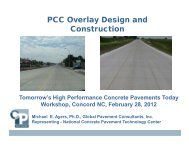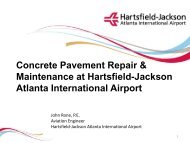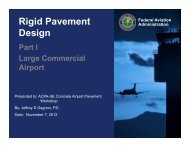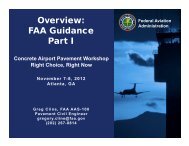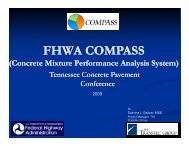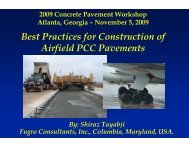Concrete Airfield Pavement Design - Using FAARFIELD for g Rigid ...
Concrete Airfield Pavement Design - Using FAARFIELD for g Rigid ...
Concrete Airfield Pavement Design - Using FAARFIELD for g Rigid ...
- No tags were found...
You also want an ePaper? Increase the reach of your titles
YUMPU automatically turns print PDFs into web optimized ePapers that Google loves.
<strong>Concrete</strong> <strong>Airfield</strong><strong>Pavement</strong> <strong>Design</strong> -<strong>Using</strong> <strong>FAARFIELD</strong> <strong>for</strong><strong>Rigid</strong> OverlaysFederal AviationAdministrationPresented to: <strong>Concrete</strong> Airport <strong>Pavement</strong> WorkshopRight Choice, Right NowAtlanta, GeorgiaPresented by: Navneet Garg, Ph.D.Date: November 4, 2009
2010 FAA WorldwideAirport TechnologyTransfer ConferenceNext Generation ofAirport TechnologySponsored By:-FAA-AAAE<strong>Concrete</strong> <strong>Airfield</strong> <strong>Pavement</strong> <strong>Design</strong> <strong>Using</strong> <strong>FAARFIELD</strong> <strong>for</strong> <strong>Rigid</strong> OverlaysNovember 4, 2009Federal AviationAdministration2
In<strong>for</strong>mation on Disk1. FAA Computer Programsi. <strong>FAARFIELD</strong> 1.3ii. LEDFAA 1.3iii. FEAFAA 1.4iv. BAKFAAv. COMFAA 2.0 & Equivalent Traffic Spreadsheetvi. ProFAA2. Advisory Circularsi. 150/5320-6E Airport <strong>Pavement</strong> <strong>Design</strong> & Evaluationii. 150/5320-6D: Airport <strong>Pavement</strong> <strong>Design</strong> & Evaluation (CANCELLED)iii. 150/5335-5A: Standardized Method of Reporting Airport <strong>Pavement</strong> Strength – PCNiv.150/5370-10D: 10D Standards d <strong>for</strong> Specifying i Construction ti of Airportsv. 150/5370-11A: Use of Nondestructive Testing in the Evaluation of Airport<strong>Pavement</strong>svi. 150/5380-9: Guidelines and Procedures <strong>for</strong> Measuring <strong>Airfield</strong> <strong>Pavement</strong>Roughness3. Presentations4. Contact List<strong>Concrete</strong> <strong>Airfield</strong> <strong>Pavement</strong> <strong>Design</strong> <strong>Using</strong> <strong>FAARFIELD</strong> <strong>for</strong> <strong>Rigid</strong> OverlaysNovember 4, 2009Federal AviationAdministration3
Federal Aviation AdministrationAirport Technology R&D Program• Research conducted at the FAA William J.Hughes Technical Center, Atlantic City, NJ,USA.• Sponsor: FAA Office of Airport Safety andStandards, Washington, DC. (AAS-100)• Provide support <strong>for</strong> development of FAApavement standards (Advisory Circulars).• http://www.airporttech.tc.faa.gov/h t /<strong>Concrete</strong> <strong>Airfield</strong> <strong>Pavement</strong> <strong>Design</strong> <strong>Using</strong> <strong>FAARFIELD</strong> <strong>for</strong> <strong>Rigid</strong> OverlaysNovember 4, 2009Federal AviationAdministration4
Location of FAA Technical CenterPhiladelphiaWashingtonNew YorkFAA Technical CenterAtlantic City, New Jersey* Outline map of USA used by permission of the University of Texas Libraries, The University of Texas at Austin.<strong>Concrete</strong> <strong>Airfield</strong> <strong>Pavement</strong> <strong>Design</strong> <strong>Using</strong> <strong>FAARFIELD</strong> <strong>for</strong> <strong>Rigid</strong> OverlaysNovember 4, 2009Federal AviationAdministration5
National Airport <strong>Pavement</strong> TestFacility (NAPTF)FACTS:• Fully enclosed facility <strong>for</strong>accelerated traffic testing ti ofairport pavements.• Full-scale pavement structuresand dlanding gear loads withprogrammed wander.• Opened in 1999.• Total construction contract was$21M.– $14M from FAA– $7M from Boeing Co. underFAA/Boeing CRDA.<strong>Concrete</strong> <strong>Airfield</strong> <strong>Pavement</strong> <strong>Design</strong> <strong>Using</strong> <strong>FAARFIELD</strong> <strong>for</strong> <strong>Rigid</strong> OverlaysNovember 4, 2009Federal AviationAdministration6
NAPTF Test <strong>Pavement</strong> Layout<strong>Concrete</strong> <strong>Airfield</strong> <strong>Pavement</strong> <strong>Design</strong> <strong>Using</strong> <strong>FAARFIELD</strong> <strong>for</strong> <strong>Rigid</strong> OverlaysNovember 4, 2009Federal AviationAdministration7
NAPTF Construction Cycle (CC)<strong>Concrete</strong> <strong>Airfield</strong> <strong>Pavement</strong> <strong>Design</strong> <strong>Using</strong> <strong>FAARFIELD</strong> <strong>for</strong> <strong>Rigid</strong> OverlaysNovember 4, 2009Federal AviationAdministration8
<strong>FAARFIELD</strong> – What Is It?FederalAviationAdministration<strong>Rigid</strong> andFlexibleIterativeeElasticLayered<strong>Design</strong>• <strong>FAARFIELD</strong> is the newFAA airport pavementthickness designprogram.• <strong>FAARFIELD</strong>supersedes LEDFAA1.3 as the standarddesign procedure inFAA Advisory Circular(AC) 150/5320-6E.• Officially releasedSeptember 30, 2009.<strong>Concrete</strong> <strong>Airfield</strong> <strong>Pavement</strong> <strong>Design</strong> <strong>Using</strong> <strong>FAARFIELD</strong> <strong>for</strong> <strong>Rigid</strong> OverlaysNovember 4, 2009Federal AviationAdministration9
FAA Legacy <strong>Design</strong> Procedures vs.LEDFAA 1.3Traffic ModelStructural ResponseModelsThickness <strong>Design</strong>MethodImplementationAC 150/5320-6D(Chapters 3 - 4)All traffic converted toequivalent departures ofdesign aircraft•Westergaard’s solution <strong>for</strong>rigid pavements•Boussinesq model used tocompute ESWL <strong>for</strong> flexible•CBR equation with alphafactor (flexible)•Apply percent of thickness tobasic design <strong>for</strong> 5000coverages (rigid)<strong>Design</strong> nomographs(spreadsheet implementationalso available)LEDFAA 1.3CDF (Cumulative DamageFactor) accounts <strong>for</strong> mixedtraffic•Layered elastic analysis(LEAF) <strong>for</strong> flexible and rigidFailure model relatescoverages to structural failureto a suitable response:subgrade strain (flexible) orconcrete stress (rigid).Desktop computer program<strong>Concrete</strong> <strong>Airfield</strong> <strong>Pavement</strong> <strong>Design</strong> <strong>Using</strong> <strong>FAARFIELD</strong> <strong>for</strong> <strong>Rigid</strong> OverlaysNovember 4, 2009Federal AviationAdministration10
FAA Legacy <strong>Design</strong> Procedures vs.<strong>FAARFIELD</strong>Traffic ModelStructural ResponseModelsThickness <strong>Design</strong>MethodImplementationAC 150/5320-6D(Chapters 3 - 4)All traffic converted toequivalent departures ofdesign aircraft•Westergaard’s solution <strong>for</strong>rigid pavements•Boussinesq model used tocompute ESWL <strong>for</strong> flexible•CBR equation with alphafactor (flexible)•Apply percent of thickness tobasic design <strong>for</strong> 5000coverages (rigid)<strong>Design</strong> nomographs(spreadsheet implementationalso available)<strong>FAARFIELD</strong> 1.3CDF (Cumulative DamageFactor) accounts <strong>for</strong> mixedtraffic•Layered elastic analysis(LEAF) <strong>for</strong> flexible.•3D finite element <strong>for</strong> rigid.Failure model relatescoverages to structural failureto a suitable response:subgrade strain (flexible) orconcrete stress (rigid).Desktop computer programVisual Studio 2005<strong>Concrete</strong> <strong>Airfield</strong> <strong>Pavement</strong> <strong>Design</strong> <strong>Using</strong> <strong>FAARFIELD</strong> <strong>for</strong> <strong>Rigid</strong> OverlaysNovember 4, 2009Federal AviationAdministration11
<strong>FAARFIELD</strong> – Technical Background• Computer program <strong>for</strong> desktop PCs.• Program preserves the “look and feel”of LEDFAA 1.3.• Major changes are internal.• Main program drives threesubprograms:– LEAF (layered elastic analysis)– NIKE3D (3D finite element analysis)– INGRID (3D mesh generation)• NIKE3D and INGRID in<strong>for</strong>mation:– Modified <strong>for</strong> <strong>FAARFIELD</strong> by the FAA– Distributed in compiled <strong>for</strong>m under asoftware sharing agreement with LawrenceLivermore National Laboratory (LLNL)<strong>Concrete</strong> <strong>Airfield</strong> <strong>Pavement</strong> <strong>Design</strong> <strong>Using</strong> <strong>FAARFIELD</strong> <strong>for</strong> <strong>Rigid</strong> OverlaysNovember 4, 2009Federal AviationAdministration12
<strong>FAARFIELD</strong> 1.3Key Differences from LEDFAA 1.3• <strong>Rigid</strong> <strong>Pavement</strong>s/Overlays– Slab edge stresses are now computed directly using 3D-FEM.– Completely revised rigid pavement failure model.– Rewrote and improved rigid overlay design procedures.• Flexible <strong>Pavement</strong>s/Overlays– Automatic base thickness design.– Improved Pass-to-Coverage ratio computation routine.– Supports HMA overlay design on rubblized PCC base.• General– Upgrade to MS Visual Basic 2005 programming environment.– Aircraft library updated.– New function allows user to export design data to XML.– Improved <strong>for</strong>matting <strong>for</strong> Notes.– All user options collected on one “Options” screen.<strong>Concrete</strong> <strong>Airfield</strong> <strong>Pavement</strong> <strong>Design</strong> <strong>Using</strong> <strong>FAARFIELD</strong> <strong>for</strong> <strong>Rigid</strong> OverlaysNovember 4, 2009Federal AviationAdministration13
<strong>FAARFIELD</strong> 1.3• <strong>Pavement</strong> thickness is now computed <strong>for</strong>constant tire contact area.– Changing the airplane gross weight causes the tirepressure to be adjusted to maintain the contact area.• External aircraft library in XML <strong>for</strong>mat.• Displays CDF values graphically.• Enhanced Airplane Data window nowdisplays gear coordinates.• Support <strong>for</strong> PCC over rubblized base.• Aircraft changed to Airplane(s).<strong>Concrete</strong> <strong>Airfield</strong> <strong>Pavement</strong> <strong>Design</strong> <strong>Using</strong> <strong>FAARFIELD</strong> <strong>for</strong> <strong>Rigid</strong> OverlaysNovember 4, 2009Federal AviationAdministration14
Cumulative Damage Factor (CDF)• Sums the damage contributed from each aircraft -not from equivalent aircraft.• CDF = Σ (n i /N i ), where:– n i = actual passes of individual aircraft i– N i = allowable passes of individual aircraft i• When CDF = 1, design life is exhausted.• In <strong>FAARFIELD</strong> (and LEDFAA 1.3):– The gear location and wander are considered separately <strong>for</strong>each aircraft in the total mix.– CDF is calculated <strong>for</strong> each 25.4 cm (10 inch) wide strip over atotal 20.83 m (820 inch) width.– Miner’s rule to sum damage <strong>for</strong> each strip.• Must input the fleet mix, NOT equivalent departuresof design aircraft.<strong>Concrete</strong> <strong>Airfield</strong> <strong>Pavement</strong> <strong>Design</strong> <strong>Using</strong> <strong>FAARFIELD</strong> <strong>for</strong> <strong>Rigid</strong> OverlaysNovember 4, 2009Federal AviationAdministration15
Cumulative Damage Factor (CDF)Difference in GearLocationCDFDamage fromAirplane ADamage fromAirplane B25.4 cm (10 in.)<strong>Concrete</strong> <strong>Airfield</strong> <strong>Pavement</strong> <strong>Design</strong> <strong>Using</strong> <strong>FAARFIELD</strong> <strong>for</strong> <strong>Rigid</strong> OverlaysNovember 4, 2009Federal AviationAdministration16
Cumulative Damage Factor (CDF)25.4 cm (10 in.) Total DamageCDFDamage fromAirplane ADamage fromAirplane B<strong>Concrete</strong> <strong>Airfield</strong> <strong>Pavement</strong> <strong>Design</strong> <strong>Using</strong> <strong>FAARFIELD</strong> <strong>for</strong> <strong>Rigid</strong> OverlaysNovember 4, 2009Federal AviationAdministration17
Large Airplane Traffic Mix GearLocationsnway Cente erline .RuB-777-200B-747-400A330 A-330B-767-200A-300-B2B-757B-727B-737-400MD-83MD-90-30DC-9-50DW 100,000Regional Jet 700Regional Jet 200DW 45,000DW 30,000SW 30,0000000 25 50 75 100 125 150 175 200 225 250 275 300 325 350 375 400Distance From Centerline (in)<strong>Concrete</strong> <strong>Airfield</strong> <strong>Pavement</strong> <strong>Design</strong> <strong>Using</strong> <strong>FAARFIELD</strong> <strong>for</strong> <strong>Rigid</strong> OverlaysNovember 4, 2009Federal AviationAdministration18
<strong>FAARFIELD</strong> – CDF Graphical Display<strong>Concrete</strong> <strong>Airfield</strong> <strong>Pavement</strong> <strong>Design</strong> <strong>Using</strong> <strong>FAARFIELD</strong> <strong>for</strong> <strong>Rigid</strong> OverlaysNovember 4, 2009Federal AviationAdministration19
Remember - in <strong>FAARFIELD</strong>Use the entire traffic mix!<strong>Concrete</strong> <strong>Airfield</strong> <strong>Pavement</strong> <strong>Design</strong> <strong>Using</strong> <strong>FAARFIELD</strong> <strong>for</strong> <strong>Rigid</strong> OverlaysNovember 4, 2009Federal AviationAdministration20
<strong>FAARFIELD</strong> System/SoftwareRequirementsMinimumRecommended• Windows 2000• Windows XP• 600 MHz Pentium III processor • 2 GHz Pentium IV processor• 256 MB memory• 512 MB memory• 200 MB of available space onhard drive.• Users of older operating systemsmay require a one-timeinstallation of the .NETFramework (free download fromMicrosoft).• Users of older operating systemsmay require a one-timeinstallation of the .NETFramework (free download fromMicrosoft).<strong>Concrete</strong> <strong>Airfield</strong> <strong>Pavement</strong> <strong>Design</strong> <strong>Using</strong> <strong>FAARFIELD</strong> <strong>for</strong> <strong>Rigid</strong> OverlaysNovember 4, 2009Federal AviationAdministration21
Running <strong>FAARFIELD</strong>:Program Windows and LinkageNOTESAdditional SectionIn<strong>for</strong>mation andDetailed Output DataSTARTUPControl andOrganizationOPTIONSSet User Optionsand TolerancesExport XMLSTRUCTUREStructure Data Inputand <strong>Design</strong>AIRCRAFTAircraft Load andTraffic Data InputAIRCRAFT DATAView Landing GearGeometry, Load, andTire Pressure<strong>Concrete</strong> <strong>Airfield</strong> <strong>Pavement</strong> <strong>Design</strong> <strong>Using</strong> <strong>FAARFIELD</strong> <strong>for</strong> <strong>Rigid</strong> OverlaysNovember 4, 2009Federal AviationAdministration22
<strong>FAARFIELD</strong> Input RequirementsStructure WindowAirplane Window• For each structural layer:– Material type (FAA specification)– Layer Thickness– Modulus or R-value (if applicable)• There are built-in restrictions on thelayer types, including relative positionand layer properties.• For subgrade, can enter CBR or k and<strong>FAARFIELD</strong> will convert to E.• Select airplane from library.• For each airplane in the mix:– Aircraft Name– Gross Taxi Weight– Annual departures and percent annualgrowth if applicable• Enter data <strong>for</strong> all airplanes in the mix.<strong>Concrete</strong> <strong>Airfield</strong> <strong>Pavement</strong> <strong>Design</strong> <strong>Using</strong> <strong>FAARFIELD</strong> <strong>for</strong> <strong>Rigid</strong> OverlaysNovember 4, 2009Federal AviationAdministration23
<strong>FAARFIELD</strong> Job Files (JOB.xml)• Job files in <strong>FAARFIELD</strong> 1.3 are in XML<strong>for</strong>mat. This is a different <strong>for</strong>mat thanprevious job files in LEDFAA.• <strong>FAARFIELD</strong> looks <strong>for</strong> old job files in theworking directory and automaticallyconverts them to the new XML <strong>for</strong>mat.– After reading, the old job files are moved to asubdirectory of the working directory calledold_job_files.– All subsequent changes are written to the JOB.xmlfiles only. The old job files are not changed.<strong>Concrete</strong> <strong>Airfield</strong> <strong>Pavement</strong> <strong>Design</strong> <strong>Using</strong> <strong>FAARFIELD</strong> <strong>for</strong> <strong>Rigid</strong> OverlaysNovember 4, 2009Federal AviationAdministration24
Structural Models in <strong>FAARFIELD</strong> 1.3• Both layered elastic (LEAF)and d3DFEM 3D-FEM (NIKE3D) areused in <strong>FAARFIELD</strong>.• Flexible pavement design– LEAF is used <strong>for</strong> all structuralcomputations.– For flexible, no advantage tousing 3D-FEM.• <strong>Rigid</strong> pavement design– LEAF is used to generate apreliminary thickness.– Final iterations are doneusing 3D-FEM.E 1 , ν 12aqh 1h 2E h 2 , ν 22E 3 , ν 3<strong>Concrete</strong> <strong>Airfield</strong> <strong>Pavement</strong> <strong>Design</strong> <strong>Using</strong> <strong>FAARFIELD</strong> <strong>for</strong> <strong>Rigid</strong> OverlaysNovember 4, 2009Federal AviationAdministration25
3D-FEM <strong>Rigid</strong> <strong>Pavement</strong> MeshDisplayed <strong>Using</strong> NikePlot UtilityModel includes 1 or2 slabs (i.e., basePCC and overlay)Multiple Base LayersNot Visible to theUser During <strong>Design</strong>Subgrade(“Infinite” Elements)<strong>Concrete</strong> <strong>Airfield</strong> <strong>Pavement</strong> <strong>Design</strong> <strong>Using</strong> <strong>FAARFIELD</strong> <strong>for</strong> <strong>Rigid</strong> OverlaysNovember 4, 2009Federal AviationAdministration26
3D-FEM Stress ResponseStress σ yy Contours Displayed <strong>Using</strong> NikePlot•3D-FEM responses arenot visible to the userduring design.<strong>Concrete</strong> <strong>Airfield</strong> <strong>Pavement</strong> <strong>Design</strong> <strong>Using</strong> <strong>FAARFIELD</strong> <strong>for</strong> <strong>Rigid</strong> OverlaysNovember 4, 2009Federal AviationAdministration27
Traffic Mix <strong>for</strong> This ExampleNo. Name Gross Wt., lbsAnnualDepartures% AnnualGrowth1 RegionalJet-200 47,450450 1,000 02 RegionalJet-700 72,500 800 03 Canadair-CL-215 33,000 600 04 DC-3 26,900 500 05 Gulfstream-G-V 90,900 200 0<strong>Concrete</strong> <strong>Airfield</strong> <strong>Pavement</strong> <strong>Design</strong> <strong>Using</strong> <strong>FAARFIELD</strong> <strong>for</strong> <strong>Rigid</strong> OverlaysNovember 4, 2009Federal AviationAdministration28
New <strong>Rigid</strong> Example Set-UpCreate a new sectionin job PROJECT bydragging sectionNew<strong>Rigid</strong> id in Samplesto PROJECT.<strong>Concrete</strong> <strong>Airfield</strong> <strong>Pavement</strong> <strong>Design</strong> <strong>Using</strong> <strong>FAARFIELD</strong> <strong>for</strong> <strong>Rigid</strong> OverlaysNovember 4, 2009Federal AviationAdministration29
New <strong>Rigid</strong> <strong>Pavement</strong> <strong>Design</strong> Example• <strong>Pavement</strong> Structure:– PCC Slab, P-501, R = 710 psi– Cement-Treated Base, P-304, 6 inches thick– Crushed Aggregate Base, P-209, 8 inches thick– Subgrade k = 100 pci• Traffic Mix:– 5-Aircraft Mix includes (less than 100,000 lbs)<strong>Concrete</strong> <strong>Airfield</strong> <strong>Pavement</strong> <strong>Design</strong> <strong>Using</strong> <strong>FAARFIELD</strong> <strong>for</strong> <strong>Rigid</strong> OverlaysNovember 4, 2009Federal AviationAdministration30
Change <strong>Pavement</strong> StructureIn Structure window,click on ModifyStructure<strong>Concrete</strong> <strong>Airfield</strong> <strong>Pavement</strong> <strong>Design</strong> <strong>Using</strong> <strong>FAARFIELD</strong> <strong>for</strong> <strong>Rigid</strong> OverlaysNovember 4, 2009Federal AviationAdministration31
Change <strong>Pavement</strong> StructureClick R to 710 psiChange base layer toCTB, P-304, 6 inChange P-209 layerthickness to 8 inChange subgrade k to100 pciClick “End Modify”<strong>Concrete</strong> <strong>Airfield</strong> <strong>Pavement</strong> <strong>Design</strong> <strong>Using</strong> <strong>FAARFIELD</strong> <strong>for</strong> <strong>Rigid</strong> OverlaysNovember 4, 2009Federal AviationAdministration32
Change <strong>Pavement</strong> StructureClick “Save Structure”<strong>Concrete</strong> <strong>Airfield</strong> <strong>Pavement</strong> <strong>Design</strong> <strong>Using</strong> <strong>FAARFIELD</strong> <strong>for</strong> <strong>Rigid</strong> OverlaysNovember 4, 2009Federal AviationAdministration33
Add Airplane ListClick on “Clear List”to clear the sampleairplanes from thedesign list.<strong>Concrete</strong> <strong>Airfield</strong> <strong>Pavement</strong> <strong>Design</strong> <strong>Using</strong> <strong>FAARFIELD</strong> <strong>for</strong> <strong>Rigid</strong> OverlaysNovember 4, 2009Federal AviationAdministration34
Add Airplane List<strong>Concrete</strong> <strong>Airfield</strong> <strong>Pavement</strong> <strong>Design</strong> <strong>Using</strong> <strong>FAARFIELD</strong> <strong>for</strong> <strong>Rigid</strong> OverlaysNovember 4, 2009Federal AviationAdministration35
Run <strong>Design</strong>•During g the designprocess, the “<strong>Design</strong>Running” clock willappear.•For rigid designs, thedesign will normallytake a few minutes.Don’t interrupt theprocess.•The screen displaywill change with eachiteration.<strong>Concrete</strong> <strong>Airfield</strong> <strong>Pavement</strong> <strong>Design</strong> <strong>Using</strong> <strong>FAARFIELD</strong> <strong>for</strong> <strong>Rigid</strong> OverlaysNovember 4, 2009Federal AviationAdministration36
New <strong>Rigid</strong> <strong>Pavement</strong> - Final <strong>Design</strong><strong>Concrete</strong> <strong>Airfield</strong> <strong>Pavement</strong> <strong>Design</strong> <strong>Using</strong> <strong>FAARFIELD</strong> <strong>for</strong> <strong>Rigid</strong> OverlaysNovember 4, 2009Federal AviationAdministration37
<strong>FAARFIELD</strong> Overlay <strong>Design</strong>• HMA Overlays on Flexible <strong>Pavement</strong>– Same as designing a new flexible pavement, except the designlayer is the HMA overlay.• PCC Overlays on Flexible e <strong>Pavement</strong>e – Same principle as new rigid design.• HMA Overlays on <strong>Rigid</strong> <strong>Pavement</strong>• PCC Overlays on <strong>Rigid</strong> <strong>Pavement</strong>– More complex than new rigid pavement design.– Both slabs (base PCC and overlay) deteriorate with appliedtraffic. Stresses are computed <strong>for</strong> both slabs.– E-modulus of the base slab is a function of reduced SCI.– Subroutines were completely rewritten <strong>for</strong> <strong>FAARFIELD</strong>.<strong>Concrete</strong> <strong>Airfield</strong> <strong>Pavement</strong> <strong>Design</strong> <strong>Using</strong> <strong>FAARFIELD</strong> <strong>for</strong> <strong>Rigid</strong> OverlaysNovember 4, 2009Federal AviationAdministration38
<strong>FAARFIELD</strong> Overlay <strong>Design</strong> –PCC on <strong>Rigid</strong> Overlays• Fully bonded overlays– Treat as a new rigid pavement design.– Thickness of overlay slab is h overlay = h design – h exist .• Unbonded d overlay– Bond breaker or leveling course is used.• Partially bonded overlay– No longer a standard design in AC 150/5320-6E.– Default in <strong>FAARFIELD</strong> is off.– May be enabled from the Options window, butdisplays a “Non Standard Structure” message.<strong>Concrete</strong> <strong>Airfield</strong> <strong>Pavement</strong> <strong>Design</strong> <strong>Using</strong> <strong>FAARFIELD</strong> <strong>for</strong> <strong>Rigid</strong> OverlaysNovember 4, 2009Federal AviationAdministration39
<strong>FAARFIELD</strong> Overlay <strong>Design</strong>Required Inputs• Existing rigid pavement condition is characterized by theStructural Condition Index (SCI).• SCI derived from PCI as determined by ASTM D 5340 Airport<strong>Pavement</strong> Condition Index Surveys. The new AC givesguidance on SCI.• SCI is computed using only structural t components from thePCI survey.• SCI = 80, FAA definition of structural failure (50% of slabs withstructural crack)• For existing pavements with structural damage (SCI < 100)– The user inputs a value of SCI <strong>for</strong> the existing pavement. The range ofallowable values depends on the overlay type:• <strong>Rigid</strong> on <strong>Rigid</strong> Overlays: SCI 40–100• Flexible on <strong>Rigid</strong> Overlays: SCI 67–100 (was 50-100)– The Help file gives approximate <strong>for</strong>mulas <strong>for</strong> relating SCI to Cr and Cbfactors in earlier method.<strong>Concrete</strong> <strong>Airfield</strong> <strong>Pavement</strong> <strong>Design</strong> <strong>Using</strong> <strong>FAARFIELD</strong> <strong>for</strong> <strong>Rigid</strong> OverlaysNovember 4, 2009Federal AviationAdministration40
<strong>FAARFIELD</strong> – PCC Unbonded Overlay<strong>Design</strong> Structural Condition Index (SCI)<strong>Rigid</strong> <strong>Pavement</strong> Distress Types Used to Calculate SCIDistressCorner BreakLongitudinal/Transverse/Diagonal CrackingShattered SlabShrinkage Cracks (cracking partial width of slab)*Spalling–JointSpalling–CornerSeverity LevelLow, Medium, HighLow, Medium, HighLow, Medium, HighLowLow, Medium, HighLow, Medium, High* Used only to describe a load-induced crack that extends only part of the way acrossa slab. The SCI does not include conventional shrinkage cracks due to curing orother non load-related problems.<strong>Concrete</strong> <strong>Airfield</strong> <strong>Pavement</strong> <strong>Design</strong> <strong>Using</strong> <strong>FAARFIELD</strong> <strong>for</strong> <strong>Rigid</strong> OverlaysNovember 4, 2009Federal AviationAdministration41
Cumulative Damage Factor Used (CDFU)• For existing pavements where SCI=100(no structural distress):– There is no visible distress contributing to reductionin SCI (no structural distress types). However, somepavement life has been consumed by the appliedtraffic.– The amount of pavement life consumed is thepercent CDF Used (%CDFU).– Need to estimate a value of %CDFU.– The Help file gives guidance on estimating %CDFUusing the Life key.<strong>Concrete</strong> <strong>Airfield</strong> <strong>Pavement</strong> <strong>Design</strong> <strong>Using</strong> <strong>FAARFIELD</strong> <strong>for</strong> <strong>Rigid</strong> OverlaysNovember 4, 2009Federal AviationAdministration42
Cumulative Damage Factor Used (CDFU)– CDFU defines the amount of structural life used.• For structures with aggregate base:• L U = number of years of operation of the existing pavement until overlay• L D = design life of the existing pavement in years– <strong>FAARFIELD</strong> modifies this relationship <strong>for</strong> stabilizedsubbases to reflect improved per<strong>for</strong>mance.<strong>Concrete</strong> <strong>Airfield</strong> <strong>Pavement</strong> <strong>Design</strong> <strong>Using</strong> <strong>FAARFIELD</strong> <strong>for</strong> <strong>Rigid</strong> OverlaysNovember 4, 2009Federal AviationAdministration43
PCC on <strong>Rigid</strong> Overlay Example• Existing PCC structure will receive a P-501 PCCoverlay to support additional traffic.– Assume R <strong>for</strong> new concrete = 700 psi.• Existing <strong>Pavement</strong> Structure:– PCC Slab, 10 in, R = 710 psiSCI = 100. Estimate %CDFU from traffic history.– Cement Treated Base, P-304, 6 in– Crushed Aggregate Base, P-209, 8 in– Subgrade k = 100 pci• <strong>Design</strong> Traffic Mix:– Use same traffic mix as in the new rigid pavement designexample.<strong>Concrete</strong> <strong>Airfield</strong> <strong>Pavement</strong> <strong>Design</strong> <strong>Using</strong> <strong>FAARFIELD</strong> <strong>for</strong> <strong>Rigid</strong> OverlaysNovember 4, 2009Federal AviationAdministration44
Estimate %CDFU (Example)•Assume the following traffic mix was applied to theexisting pavement:No.NameGross Wt.,lbsAnnualDepartures% AnnualGrowth1 RegionalJet-200 47,450 1,000 02 RegionalJet-700 72,500 800 03 Canadair-CL-215 33,000 600 04 DC-3 26,900 500 05 Gulfstream-G-V G 90,900900 200 0•Assume that at the time of the overlay the pavement willhave been in operation 12 years.<strong>Concrete</strong> <strong>Airfield</strong> <strong>Pavement</strong> <strong>Design</strong> <strong>Using</strong> <strong>FAARFIELD</strong> <strong>for</strong> <strong>Rigid</strong> OverlaysNovember 4, 2009Federal AviationAdministration45
Procedure to Estimate %CDFU• Input the original pavement structure.• Estimate the annual traffic applied to theexisting pavement up to the time of theoverlay.• Set “<strong>Design</strong> Life” to the number of years thepavement will have been in operation at thetime of the overlay. Assume that at the timeof the overlay the pavement will have beenin operation 12 years.• Run “Life” to obtain %CDFU.<strong>Concrete</strong> <strong>Airfield</strong> <strong>Pavement</strong> <strong>Design</strong> <strong>Using</strong> <strong>FAARFIELD</strong> <strong>for</strong> <strong>Rigid</strong> OverlaysNovember 4, 2009Federal AviationAdministration46
Estimate %CDFU (Example)In the Structurewindow, change thedesign life to thenumber of years thattthe pavement willhave been in serviceat the time of overlay(12 years in thisexample.)Click End Modify<strong>Concrete</strong> <strong>Airfield</strong> <strong>Pavement</strong> <strong>Design</strong> <strong>Using</strong> <strong>FAARFIELD</strong> <strong>for</strong> <strong>Rigid</strong> OverlaysNovember 4, 2009Federal AviationAdministration47
Estimate %CDFU (Example)Click Life to run Life.The calculated%CDFU will appear onthe Structure window,at the lower left of thepavement section.%CDFU = 84.83 (Say85%).<strong>Concrete</strong> <strong>Airfield</strong> <strong>Pavement</strong> <strong>Design</strong> <strong>Using</strong> <strong>FAARFIELD</strong> <strong>for</strong> <strong>Rigid</strong> OverlaysNovember 4, 2009Federal AviationAdministration48
PCC on <strong>Rigid</strong> Overlay – ChangeStructureIn the Structurewindow, click ModifyStructure.<strong>Concrete</strong> <strong>Airfield</strong> <strong>Pavement</strong> <strong>Design</strong> <strong>Using</strong> <strong>FAARFIELD</strong> <strong>for</strong> <strong>Rigid</strong> OverlaysNovember 4, 2009Federal AviationAdministration49
PCC on <strong>Rigid</strong> Overlay – ChangeStructureClick Add/DeleteLayer.Select the PCCsurface layer byclicking on it with themouse. In the dialogbox, select Add andclick OK. A new PCCsurface layer appears.<strong>Concrete</strong> <strong>Airfield</strong> <strong>Pavement</strong> <strong>Design</strong> <strong>Using</strong> <strong>FAARFIELD</strong> <strong>for</strong> <strong>Rigid</strong> OverlaysNovember 4, 2009Federal AviationAdministration50
PCC on <strong>Rigid</strong> Overlay – ChangeStructureYou must change thetop layer to anoverlay. Click on theLayer Material box.In the Layer TypeSelection Box, select“Overlay FullyUnbonded” and clickOK.<strong>Concrete</strong> <strong>Airfield</strong> <strong>Pavement</strong> <strong>Design</strong> <strong>Using</strong> <strong>FAARFIELD</strong> <strong>for</strong> <strong>Rigid</strong> OverlaysNovember 4, 2009Federal AviationAdministration51
PCC on <strong>Rigid</strong> Overlay – ChangeStructureIn the upper rightcorner of theStructure window:- Change “<strong>Design</strong> Life”to 20 years (standard).- Change SCI to 100.- Change %CDFU to 85.Change R (overlay) to700 psi.Click End Modify.<strong>Concrete</strong> <strong>Airfield</strong> <strong>Pavement</strong> <strong>Design</strong> <strong>Using</strong> <strong>FAARFIELD</strong> <strong>for</strong> <strong>Rigid</strong> OverlaysNovember 4, 2009Federal AviationAdministration52
PCC on <strong>Rigid</strong> Overlay – ChangeStructureClick Save Structure.Click Airplane to go tothe Airplane window.<strong>Concrete</strong> <strong>Airfield</strong> <strong>Pavement</strong> <strong>Design</strong> <strong>Using</strong> <strong>FAARFIELD</strong> <strong>for</strong> <strong>Rigid</strong> OverlaysNovember 4, 2009Federal AviationAdministration53
PCC on <strong>Rigid</strong> Overlay – ChangeAirplane List<strong>Concrete</strong> <strong>Airfield</strong> <strong>Pavement</strong> <strong>Design</strong> <strong>Using</strong> <strong>FAARFIELD</strong> <strong>for</strong> <strong>Rigid</strong> OverlaysNovember 4, 2009Federal AviationAdministration54
PCC on <strong>Rigid</strong> Overlay – ChangeAirplane ListClick Save ListClick Back to return tothe Structure window.<strong>Concrete</strong> <strong>Airfield</strong> <strong>Pavement</strong> <strong>Design</strong> <strong>Using</strong> <strong>FAARFIELD</strong> <strong>for</strong> <strong>Rigid</strong> OverlaysNovember 4, 2009Federal AviationAdministration55
Run Overlay <strong>Design</strong>Click <strong>Design</strong> Structureto run the overlaydesign.<strong>Concrete</strong> <strong>Airfield</strong> <strong>Pavement</strong> <strong>Design</strong> <strong>Using</strong> <strong>FAARFIELD</strong> <strong>for</strong> <strong>Rigid</strong> OverlaysNovember 4, 2009Federal AviationAdministration56
Example: PCC on <strong>Rigid</strong> OverlayFinal <strong>Design</strong><strong>Concrete</strong> <strong>Airfield</strong> <strong>Pavement</strong> <strong>Design</strong> <strong>Using</strong> <strong>FAARFIELD</strong> <strong>for</strong> <strong>Rigid</strong> OverlaysNovember 4, 2009Federal AviationAdministration57
http://www.airporttech.tc.faa.gov/<strong>Concrete</strong> <strong>Airfield</strong> <strong>Pavement</strong> <strong>Design</strong> <strong>Using</strong> <strong>FAARFIELD</strong> <strong>for</strong> <strong>Rigid</strong> OverlaysNovember 4, 2009Federal AviationAdministration58


